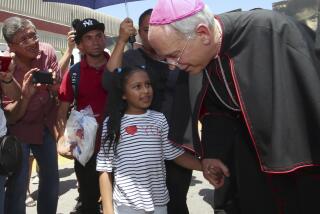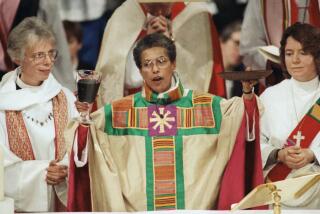‘Married Priests’ Plead for Church Roles : Would Be a Way for Catholics to Renew Pastoral Ranks, They Argue
- Share via
WASHINGTON — Patrick Sorohan owns and manages a community bookstore in Lancaster, Ohio. He has four young daughters, and he and his wife serve as lay readers in their local Catholic parish.
Sorohan is also, in his view, a Roman Catholic priest. Thirteen years ago he sought and received formal “dispensation” from priestly ministry, and his hope is to return to the priesthood with his wife and family. “He’s ready, willing and able,” said his wife, Martha.
From June 17-19 here, the couple joined more than 400 other former priests and their wives for what was billed as the first national gathering of “married priests.” They called on the church to abandon rules requiring a celibate priesthood and draw on former priests to ease the worsening shortage of priests.
‘Starving the Community’
“Mandatory celibacy is starving the Catholic community of sufficient ordained priests,” said a statement issued at the close of the gathering at American University.
The conference, sponsored by the Corps of Reserve Priests United for Service, also called on the American church to “initiate a widespread program of identification and reconciliation with inactive priests.”
There are about 100,000 married ex-priests worldwide, and more than 17,000 of them live in the United States, according to the Corps of Reserve Priests United for Service, which claims a membership of 5,000. The group cited studies that say many of them would return to active ministry if allowed to do so.
During his visit to the United States last September, Pope John Paul II repeated the church’s policy of celibacy and urged Catholic leaders to encourage young people to accept that calling.
Meanwhile, the church in the United States is looking for ways to cope with the shortage of priests. Ten percent of Catholic parishes are without resident priests. There are 58,382 active and retired priests in this country.
The former priests contended that mandatory celibacy is the chief obstacle to attracting new recruits. They pointed to a study conducted by Catholic University sociologist Dean Hoge, which projected that clergy ranks would double or triple if the priesthood were open to married men.
“Obligatory celibacy has lost the support of Scripture, history, tradition, pastoral life and the life and minds of God’s people,” theologian and ex-priest Anthony T. Padovano said during the keynote speech to the gathering. “By every standard we can measure, the time for a married priesthood has come.”
‘Anti-Life Church’
Padovano said those who left the priesthood for marriage feel stigmatized and unwanted by the church. Very few are involved in full-time religious work, and some have left the church altogether.
“If the church can’t find an adequate place for married priests and their families, it becomes, at least to that extent, an anti-life church,” charged Padovano, who drafted position papers for the U.S. hierarchy before he left the priesthood. He teaches at a state college in Mahwah, N.J.
The conviction among “married priests” that they are still priests stems from Catholic theology, which holds that the sacrament of ordination can never be revoked.
Under Catholic canon law, those who want to leave the clergy and marry must receive a special dispensation from their priestly functions. Many priests, especially during the social and religious tumult of the 1960s, married without submitting to this process called “laicization.”
Sorohan, the bookstore owner, said his desire to return to active ministry has become stronger as he has seen “parishes close down because there aren’t enough priests.”
Some former priests are not waiting for a change in church rules and have begun to perform priestly or quasi-priestly functions. They point out that under “emergency conditions,” such as in hospitals or when someone is near death, church law dictates that priests, active or inactive, perform sacraments. The critical shortage of priests has presented such an emergency, according to these former priests.
Jim Peterman, who is 60 and a married former priest living in West Palm Beach, Fla., said he has begun to perform weddings for divorced Catholics, Catholic-Jewish couples and others who encounter obstacles in seeking a church wedding. He is permitted to do so as a notary under Florida law.
Hold Own Liturgies
Some former priests and their families have joined to hold their own liturgies instead of attending established parishes. Carl Hemmer, an economist for the U.S. Agency for International Development in Washington, celebrates Mass at these “house churches” and officiates at baptisms.
Terrance Sweeney of Los Angeles said that after a hard “spiritual adjustment” to the secular world, he has decided to begin administering sacraments without church authorization to those who come to him for them. The former Jesuit married last year after a well-publicized dispute with the Vatican over his research into the issue of married and women priests.
“People have come to me for confession, and I told them I couldn’t do it. I’m never going to do that again. Never,” he said. With his wife, Pamela, seated next to him during a break at the conference, Sweeney added: “Because we love a woman, somehow we can’t lead souls to God? That’s nonsense.”
More to Read
Sign up for Essential California
The most important California stories and recommendations in your inbox every morning.
You may occasionally receive promotional content from the Los Angeles Times.













